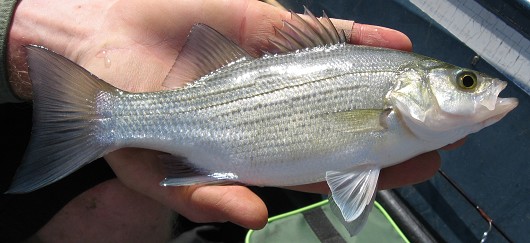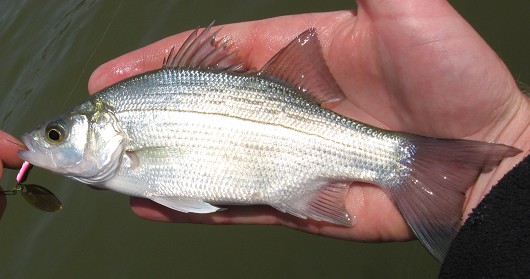White Bass
-
Scientific NameMorone chrysops
-
NativeNo
-
Identification
 White bass, caught in Nacimiento Reservoir, CA, by Teejay O'Rear. Photo by Amber Manfree.
White bass, caught in Nacimiento Reservoir, CA, by Teejay O'Rear. Photo by Amber Manfree. White bass with lure in mouth, caught in Nacimiento Reservoir, CA, by Teejay O'Rear. Photo by Amber Manfree.
White bass with lure in mouth, caught in Nacimiento Reservoir, CA, by Teejay O'Rear. Photo by Amber Manfree.- Deep, laterally compressed body with the back rising steeply behind the head
- Small head with large, slightly oblique mouth
- Maxillae extend beyond the middle of the eye
- Silvery white with 4-7 dark stripes on the sides
- Distinctly forked tail
- Single sharp spine on the operculum
- Margin of the preopercular bone is distinctly saw-toothed
- 2 distinct dorsal fins, the first with 9 spines and the second with 1 spine and 13-15 rays
- Anal fin with 3 spines and 12-13 rays
- Pelvic fins with 1 spine and 5 rays each
- Pectoral fins with 15-17 rays
- 52-60 scales along the lateral line
- Males have one urogenital opening behind the anus, females have two
-
Life History
White Bass are most common in the open waters of large lakes and reservoirs or in slow moving rivers, and thrive when these waters are warm and slightly alkaline. Their optimal growing temperature is 28-30°C, but White Bass have been found in water as warm as 34°C. They can also be found in salinities up to 20 ppt but prefer more freshwater conditions. White Bass can most readily be observed roaming in schools at the surface, chasing after pelagic fish. Fish make up the majority of an adult’s diet in most populations, but juveniles under 2 years old and some specialized adult populations also feed heavily on zooplankton. Most feeding happens during the day in offshore areas and White Bass tend to be quiescent at night moving inshore for protection. White Bass can make impressive migrations, traveling as much as much as 200 km in half as many days using the stars as a guide to home in on spawning areas.
Maturity is reached in the spring of their second year when temperatures are between 13°C and 17°C, and the mating season lasts until temperatures reach 26°C. The first sign of spawning is usually a mass congregation of White Bass near inlet mouths. Spawning adults will then travel upstream to find preferred spawning areas. Not all White Bass migrate to spawn, however, and some lake populations will instead find steep areas with rock or gravel bottoms and considerable wave action over which to mate. Spawning involves a mass of fish rising up to the surface where eggs and milt are released together. Eggs are fertilized as they drop, then adhere to the bottom. Females spawn annually and release 61,700 to 1 million eggs per season. These embryos hatch in 40-46 hours at 16-21°C and the larvae stay in the shallows for a short time before becoming planktonic. Growth rates varies from lake to lake, with young-of-the-year growing to anywhere between 9 cm and 31 cm TL and individuals in their third year reaching 26-43 cm. On average however White Bass reach a length of 22-25 cm in their first year and 33-36 cm in their third. The highest recorded weight was an individual at 2.4 kg but it is rare to find individuals over 1.5 kg. Populations in the northern regions average 9-year lifespans, while 6 years is more common in western reservoirs.
-
Links to Other ResearchN / A

